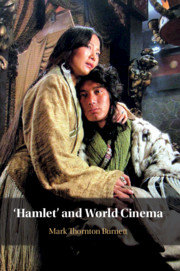78 results
Understanding Iago, An Italian Film Adaptation Of Othello: Clientelism, Corruption, Politics
-
-
- Book:
- Shakespeare Survey 75
- Published online:
- 24 August 2022
- Print publication:
- 08 September 2022, pp 1-14
-
- Chapter
-
- You have access
- HTML
- Export citation
4 - Shakespearean Cinemas/Global Directions
- from Part I - Adaptation and Its Contexts
-
-
- Book:
- The Cambridge Companion to Shakespeare on Screen
- Published online:
- 11 December 2020
- Print publication:
- 17 December 2020, pp 52-64
-
- Chapter
- Export citation
Chapter Three - Hamlet and the Moment of Brazilian Cinema
-
- Book:
- 'Hamlet' and World Cinema
- Published online:
- 21 June 2019
- Print publication:
- 04 July 2019, pp 92-120
-
- Chapter
- Export citation
Chapter Two - Thematizing Place: Hamlet, Cinema and Africa
-
- Book:
- 'Hamlet' and World Cinema
- Published online:
- 21 June 2019
- Print publication:
- 04 July 2019, pp 59-91
-
- Chapter
- Export citation
Chapter One - Hamlet, Cinema and the Histories of Western Europe
-
- Book:
- 'Hamlet' and World Cinema
- Published online:
- 21 June 2019
- Print publication:
- 04 July 2019, pp 23-58
-
- Chapter
- Export citation
Copyright page
-
- Book:
- 'Hamlet' and World Cinema
- Published online:
- 21 June 2019
- Print publication:
- 04 July 2019, pp iv-iv
-
- Chapter
- Export citation
Index
-
- Book:
- 'Hamlet' and World Cinema
- Published online:
- 21 June 2019
- Print publication:
- 04 July 2019, pp 284-292
-
- Chapter
- Export citation
Chapter Six - Gendering Borders: Hamlet and the Cinemas of Turkey and Iran
-
- Book:
- 'Hamlet' and World Cinema
- Published online:
- 21 June 2019
- Print publication:
- 04 July 2019, pp 188-218
-
- Chapter
- Export citation
A note on texts and titles
-
- Book:
- 'Hamlet' and World Cinema
- Published online:
- 21 June 2019
- Print publication:
- 04 July 2019, pp xv-xv
-
- Chapter
- Export citation
Dedication
-
- Book:
- 'Hamlet' and World Cinema
- Published online:
- 21 June 2019
- Print publication:
- 04 July 2019, pp v-vi
-
- Chapter
- Export citation
Contents
-
- Book:
- 'Hamlet' and World Cinema
- Published online:
- 21 June 2019
- Print publication:
- 04 July 2019, pp vii-vii
-
- Chapter
- Export citation
Introduction
-
- Book:
- 'Hamlet' and World Cinema
- Published online:
- 21 June 2019
- Print publication:
- 04 July 2019, pp 1-22
-
- Chapter
- Export citation
Bibliography
-
- Book:
- 'Hamlet' and World Cinema
- Published online:
- 21 June 2019
- Print publication:
- 04 July 2019, pp 256-283
-
- Chapter
- Export citation
Figures
-
- Book:
- 'Hamlet' and World Cinema
- Published online:
- 21 June 2019
- Print publication:
- 04 July 2019, pp viii-ix
-
- Chapter
- Export citation
Acknowledgements
-
- Book:
- 'Hamlet' and World Cinema
- Published online:
- 21 June 2019
- Print publication:
- 04 July 2019, pp x-xiv
-
- Chapter
- Export citation
Chapter Five - Hamlet and Indian Cinemas: Regional Paradigms
-
- Book:
- 'Hamlet' and World Cinema
- Published online:
- 21 June 2019
- Print publication:
- 04 July 2019, pp 153-187
-
- Chapter
- Export citation
Filmography
-
- Book:
- 'Hamlet' and World Cinema
- Published online:
- 21 June 2019
- Print publication:
- 04 July 2019, pp 252-255
-
- Chapter
- Export citation
Chapter Four - Pairing the Cinematic Prince: Hamlet, China and Japan
-
- Book:
- 'Hamlet' and World Cinema
- Published online:
- 21 June 2019
- Print publication:
- 04 July 2019, pp 121-152
-
- Chapter
- Export citation
Chapter Seven - Materializing Hamlet in the Cinemas of Russia, Central and Eastern Europe
-
- Book:
- 'Hamlet' and World Cinema
- Published online:
- 21 June 2019
- Print publication:
- 04 July 2019, pp 219-251
-
- Chapter
- Export citation

'Hamlet' and World Cinema
-
- Published online:
- 21 June 2019
- Print publication:
- 04 July 2019



